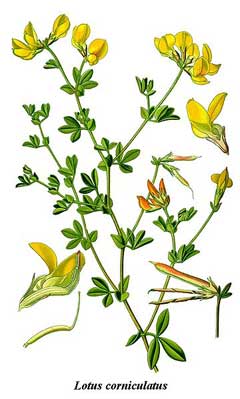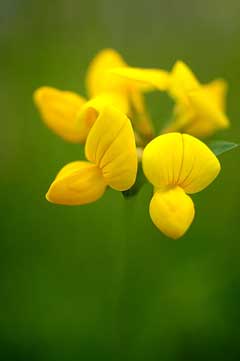 |
|
http://commons.wikimedia.org/wiki/File:Cleaned-Illustration_Lotus_corniculatus.jpg |
 |
| http://de.wikipedia.org/wiki/Benutzer:Kumbayo |
Translate this page:
Summary
Bloom Color: Yellow. Main Bloom Time: Early summer, Late spring. Form: Irregular or sprawling.
Physical Characteristics

 Lotus corniculatus is a PERENNIAL growing to 0.3 m (1ft) by 0.5 m (1ft 8in) at a medium rate.
Lotus corniculatus is a PERENNIAL growing to 0.3 m (1ft) by 0.5 m (1ft 8in) at a medium rate.
See above for USDA hardiness. It is hardy to UK zone 5. It is in flower from June to September, and the seeds ripen from August to October. The species is hermaphrodite (has both male and female organs) and is pollinated by Bees. The plant is self-fertile.
It can fix Nitrogen.
It is noted for attracting wildlife.
Suitable for: light (sandy), medium (loamy) and heavy (clay) soils, prefers well-drained soil and can grow in nutritionally poor soil. Suitable pH: mildly acid, neutral and basic (mildly alkaline) soils. It cannot grow in the shade. It prefers dry or moist soil. The plant can tolerate maritime exposure.
UK Hardiness Map
US Hardiness Map
Synonyms
Plant Habitats
Lawn; Meadow;
Edible Uses
Edible Parts: Seedpod
Edible Uses:
The young seedpods are 'nibbled'[177]. Caution is advised, see notes above on toxicity.
References More on Edible Uses
Medicinal Uses
Plants For A Future can not take any responsibility for any adverse effects from the use of plants. Always seek advice from a professional before using a plant medicinally.
Antiinflammatory Antispasmodic Cardiotonic Carminative Febrifuge Hypoglycaemic Restorative Sedative
Tonic Vermifuge
Carminative, febrifuge, hypoglycaemic, restorative, vermifuge[178]. The flowers are antispasmodic, cardiotonic and sedative[7]. The root is carminative, febrifuge, restorative and tonic[218]. The plant is used externally as a local anti-inflammatory compress in all cases of skin inflammation[7].
References More on Medicinal Uses
The Bookshop: Edible Plant Books
Our Latest books on Perennial Plants For Food Forests and Permaculture Gardens in paperback or digital formats.

Edible Tropical Plants
Food Forest Plants for Hotter Conditions: 250+ Plants For Tropical Food Forests & Permaculture Gardens.
More

Edible Temperate Plants
Plants for Your Food Forest: 500 Plants for Temperate Food Forests & Permaculture Gardens.
More

More Books
PFAF have eight books available in paperback and digital formats. Browse the shop for more information.
Shop Now
Other Uses
References More on Other Uses
Cultivation details
Landscape Uses:Border, Erosion control, Rock garden. Requires a well-drained soil in a sunny position[200]. Dislikes shade[200]. Does well on poor soils[61]. An important food plant for many caterpillars[30]. It is also a good bee plant[74], the flowers providing an important source of nectar[240]. The flowers are powerfully scented, even though they are able to pollinate themselves[245]. The plant spreads very freely at the roots[1]. This species has a symbiotic relationship with certain soil bacteria, these bacteria form nodules on the roots and fix atmospheric nitrogen. Some of this nitrogen is utilized by the growing plant but some can also be used by other plants growing nearby[200]. Special Features:Attracts butterflies. In garden design, as well as the above-ground architecture of a plant, root structure considerations help in choosing plants that work together for their optimal soil requirements including nutrients and water. The root pattern is suckering with new plants from runners away from the plant [2-1].
References Carbon Farming Information and Carbon Sequestration Information
Temperature Converter
Type a value in the Celsius field to convert the value to Fahrenheit:
Fahrenheit:
The PFAF Bookshop
Plants For A Future have a number of books available in paperback and digital form. Book titles include Edible Plants, Edible Perennials, Edible Trees,Edible Shrubs, Woodland Gardening, and Temperate Food Forest Plants. Our new book is Food Forest Plants For Hotter Conditions (Tropical and Sub-Tropical).
Shop Now
Plant Propagation
Pre-soak the seed for 24 hours in warm water and then sow in the spring or autumn in situ. The seed usually germinates in 2 - 4 weeks at 15°c. If seed is in short supply, it can be sown in pots in a cold frame. When they are large enough to handle, prick the seedlings out into individual pots and plant them out in late spring or early summer.
Other Names
If available other names are mentioned here
Native Range
TEMPERATE ASIA: Afghanistan, Cyprus, Iran, Iraq, Turkey, Russian Federation-Ciscaucasia (Ciscaucasia), Armenia, Azerbaijan, Georgia, Russian Federation (Dagestan), Russian Federation-Western Siberia (Western Siberia (southwest)), Kazakhstan, Tajikistan, Turkmenistan, Mongolia, Russian Federation (Primorye), China, Korea, Japan, Taiwan TROPICAL ASIA: India, Nepal, Pakistan EUROPE: Denmark, Finland, United Kingdom, Ireland, Norway, Sweden, Czechoslovakia, Austria, Belgium, Switzerland, Germany, Hungary, Netherlands, Poland, Russian Federation (European part), Belarus, Estonia, Lithuania, Latvia, Moldova, Ukraine (incl. Krym), Former Yugoslavia, Albania, Bulgaria, Greece, Romania, Spain, France AFRICA: Algeria (north), Morocco, Tunisia, Ethiopia, Sudan, Kenya, Tanzania
Weed Potential
Right plant wrong place. We are currently updating this section.
Please note that a plant may be invasive in one area but may not in your area so it's worth checking.
Conservation Status
IUCN Red List of Threatened Plants Status :

Growth: S = slow M = medium F = fast. Soil: L = light (sandy) M = medium H = heavy (clay). pH: A = acid N = neutral B = basic (alkaline). Shade: F = full shade S = semi-shade N = no shade. Moisture: D = dry M = Moist We = wet Wa = water.
Now available:
Food Forest Plants for Mediterranean Conditions
350+ Perennial Plants For Mediterranean and Drier Food Forests and Permaculture Gardens.
[Paperback and eBook]
This is the third in Plants For A Future's series of plant guides for food forests tailored to
specific climate zones. Following volumes on temperate and tropical ecosystems, this book focuses
on species suited to Mediterranean conditions—regions with hot, dry summers and cool, wet winters,
often facing the added challenge of climate change.
Read More
Expert comment
Author
L.
Botanical References
17200
Links / References
For a list of references used on this page please go here
Readers comment
© 2010, Plants For A Future. Plants For A Future is a charitable company limited by guarantee, registered in England and Wales. Charity No. 1057719, Company No. 3204567.